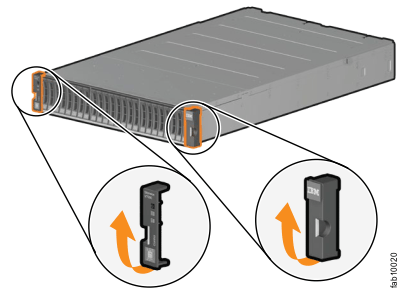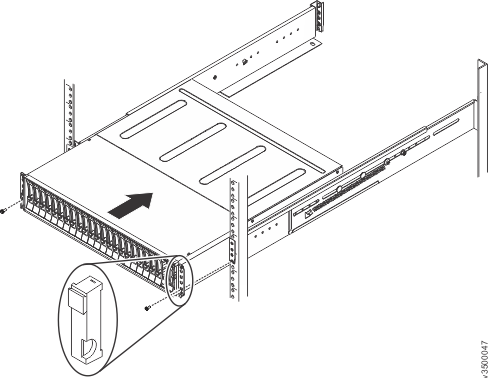Following your enclosure location plan, install the control
enclosure (and optionally, one or more expansion enclosures).
Note: For NEBS-compliant installations, more requirements
are placed on the rack into which the support rails and enclosures
are to be installed. Before you proceed, ensure that the rack meets
the requirements that are listed in
NEBS-compliant earth connection.
CAUTION:
- To lift and install the enclosure into the rack requires at least
two people.
- To lift a control enclosure with drives installed requires at
least three people.
- Load the rack from the bottom up to ensure rack stability. Empty
the rack from the top down.
To install an enclosure, complete the following steps.
- On either side of the drive assemblies, remove the enclosure
end caps by grasping the handle and pulling the bottom of the end
cap free, then clearing the tab on the top of the enclosure.
(See
Figure 1.)
Figure 1. Removing enclosure end caps
- Align the enclosure with the front of the rack cabinet.
- Carefully slide the enclosure into the rack along the rails
until the enclosure is fully inserted (see Figure 2).
Note: The rails are not designed to hold an enclosure that is
partially inserted. The enclosure must always be in a fully inserted
position.
Figure 2. Inserting the enclosure
- Secure the enclosure with a screw
in the rack mounting screw hole.
- Reinstall the left and right end
caps.
(See Figure 2.) The left end
cap has indicator windows that align with the status LEDs (light-emitting
diodes) on the edge of the enclosure.
- Ensure that the serial number of the end cap matches
the serial number on the rear of the enclosure.
- Fit the slot on the top of the end cap over the tab
on the chassis flange.
- Rotate the end cap down until it snaps into place.
- Ensure that the inside surface of the end cap
is flush with the chassis.

